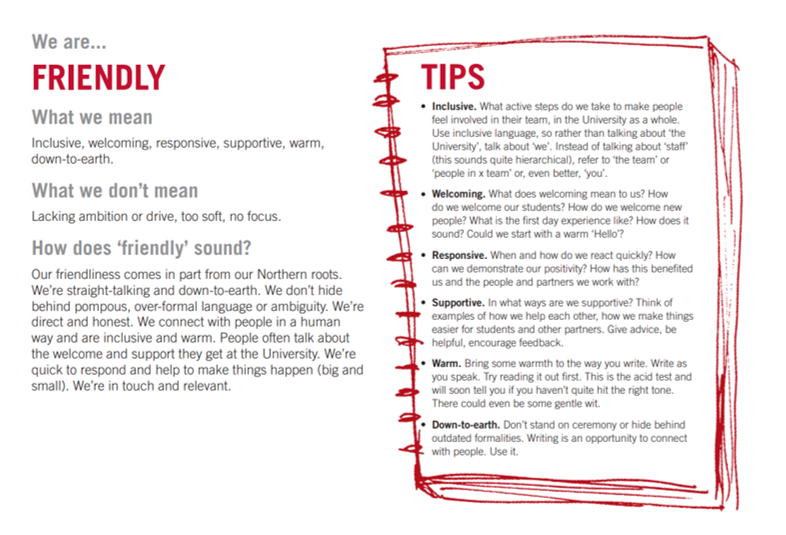Every established brand has documented brand guidelines which dictate and direct how the brand should be presented.
In the past, the term ‘brand guidelines’ was used interchangeably with ‘visual identity guidelines’. Of course, we now know ‘visual identity’ to be an inadequate descriptor – brand guidelines must address more than just how a brand should look.
Contemporary brand guidelines also govern how a brand should sound.
It’s not just what you say, it’s how you say it.
Like people, brands have personality traits. These human characteristics make brands more relatable. For example:
- The Jamie Oliver brand personality is honest and challenging; passionate and inspiring; approachable and fun.
- In contrast, Dell’s brand personality is no-nonsense, collaborative, “can do” spirit, open and optimistic.
Our personality is a fundamental part of who we are, how we express ourselves, and how we connect with others.
The same applies to brands.
A brand can convey its character through its tone of voice, or brand voice.
Beth Hendricks, who instructs on study.com, describes tone of voice as being “all about the attitude behind what you’re saying”.
Just as we read non-verbal cues such as gestures and facial expressions, so, too, are we alert to the nuances of tone. When we read or hear something, we digest it on two levels: what was said (or written) and how it was said (or written).
In fact, in marketing communications the delivery is at least as important as the message. A strong and distinctive tone of voice will identify you even when your business name or logo is hidden.
Set the tone
A brand’s tone of voice should be as consistent as its corporate colours and approved typeface. Yet, most brands haven’t defined their brand voice.
Tone of voice is a brand element which is often overlooked affirms brand strategist and Brand Aid author, Brad VanAuken.
“We talk at length about the brand promise, brand essence, brand personality, brand values. All these things lead to who the brand is, as though the brand were a person. But I don’t see anyone really adding anything about tone of voice. There’s often no real brand voice or there are so many you can pin down what it is. It’s either indeterminate or its confusing,” reflects VanAuken.
Creating a strong and consistent brand voice isn’t easy because tone of voice is comprised of many elements.
Vocabulary
What’s the level of education, the level of intellect, of your brand?
Clarity
How articulate is your brand? How truncated or complex is your sentence structure?
Tempo
What rhythm is created by variation in the length of sentences and paragraphs?
Pronouns
Does your brand use the more intimate first person (we), the direct and engaging second person (you), or the distant third person ([COMPANY/BRAND])
Formality
Does your brand use contractions (you’re, they’re, don’t…)? Does your brand use jargon (which can be industry-specific), buzzwords (which date), clichés (which tend to be overused), colloquialisms and slang (which can be country- or culture-specific)?
Grammar
Does your brand prescriptively obey long-established rules of grammar or do you bend the rules to reflect the evolution of language and sound more natural?
Style
What other idiosyncratic writing techniques illustrate your brand’s personality? For example, are metaphors, hyperbole, similes or parenthetical phrases an intrinsic part of your brand voice?
How to create a consistent tone of voice
- Understand your brand’s personality – it’s almost certainly documented in your brand guidelines, often as ‘we are… we are not’ statements. Is your brand erudite and sophisticated or casual and goofy?
- Make sure your tone of voice matches your brand’s personality. Let’s look at a few examples: sports brand PUMA, financial services brand PayPal, Coca-Cola and the University of Leeds.
Personality: Sporty, Lifestyle, Performance, Chill
Brand Voice: PUMA’s tone of voice is confident and it should always reflect the core values of the brand. The tone must also reflect our passion and love for what we do. PUMA uses humour and irony to express joy along with confidence, honesty and powerful words to state our level of determination.
Personality: Helpful, Human, Innovative, Vigilant, Courageous
Our tone and manner come from a customer-first perspective, making sure it’s simple, clear, helpful and easy to understand. The PayPal voice:
-
-
-
-
- Sounds like a human being, not a robotic script
- Is clever, but not snobby or cynical
- Uses humour to create engagement, to share a knowing smile
- When we have to deliver a tough message, a respectful tone can make all the difference
- Avoids jargon and overly technical language
- Avoids acronyms that mean nothing to people outside of PayPal
- Gets to the point quickly.
-
-
-
Personality: Authentic (real), Connected, Optimistic, Spontaneous
Brand Voice: How do we talk to people? Like people. Throughout our 120-year history, simple one-word brand statements like ‘Drink’, ‘Enjoy’ and ‘Always’ have been as iconic to Cola-Cola as the colour Coke Red. Words offering refreshment cues such as ‘Ice Cold’, ‘Delicious’ and ‘Refreshing’ are similarly part of the Coke lexicon, as are invitational messages like ‘Have a Coke’ or the more playful ‘Yes.’ The words give the brand a point of view and a personality to connect with the consumer.
Personality: Straightforward, Friendly, Imaginative, Confident
Brand Voice: Our tone of voice is the way in which we write and speak, what we say and how we say it. Like a person, what we say is dictated by our principles, experiences and aspirations, how we say it is informed by our personality…
Our personality guides how we talk and write for the University.
If a person were friendly, straightforward, imaginative and confident, how would they sound. Use the following pages for ideas on how to bring these personality traits to life in your writing.
If we are friendly, we should sound friendly. Bring some warmth to your words. Likewise, if we’re imaginative, our language should be too. No falling back on tired old clichés or bureaucratic jargon. Remember, this is as much about the style of your writing as the content…
- Document it. Include tone of voice in your brand guidelines. In doing so, be as specific as possible.
“Don’t just say your brand voice is funny because ‘funny’ can manifest itself in different ways”, counsels VanAuken. “There are so many types of humour – puns, sarcasm, vulgar humour, inside jokes, plays on words…. You need to be specific about the type of sense of humour.”
- Create a brand vocabulary list. What words and phrases are well suited to your brand’s personality and voice? What words and phrases would be off-brand?
- Don’t just tell – show. For example, check out this excerpt from the University of Leeds’ Tone of Voice Guidelines. The connection between personality and voice is clear. The guidelines also illuminate how each personality trait might sound and provide practical advice, tips and examples.
 Get a spokesperson, or create a character or persona, that absolutely exemplifies the personality you’re trying to instil. It’s much easier to achieve consistency if you have a person, character or archetype to keep you focused.
Get a spokesperson, or create a character or persona, that absolutely exemplifies the personality you’re trying to instil. It’s much easier to achieve consistency if you have a person, character or archetype to keep you focused.











